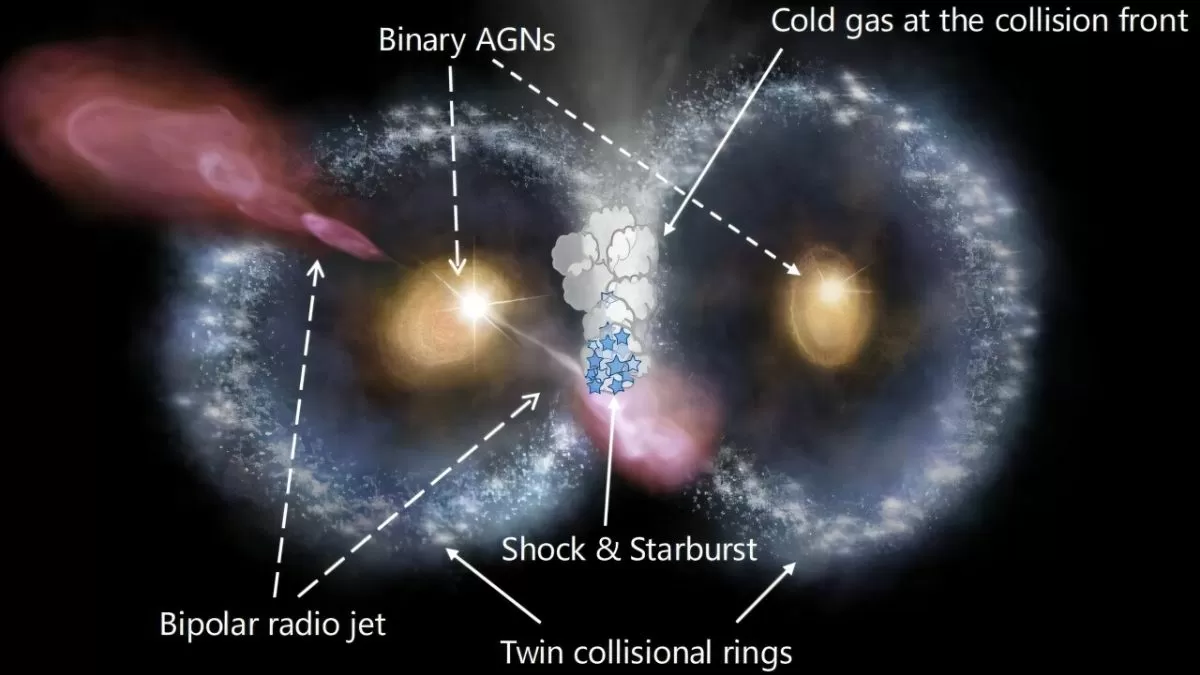NASA’s James Webb Space Telescope has once again captured a breathtaking image that has left scientists and space enthusiasts in awe. The image, dubbed the “Cosmic Owl,” showcases two colliding ring galaxies that have formed a structure resembling an owl’s face. This rare phenomenon has shed new light on galaxy evolution, black hole dynamics, and rapid star formation.
The discovery was made by Ph.D. student Mingyu Li of Tsinghua University, who led the team of researchers in analyzing the data collected by the James Webb Space Telescope. The telescope, which is set to launch in 2021, is the successor to the iconic Hubble Space Telescope and is expected to revolutionize our understanding of the universe.
The “Cosmic Owl” image is a result of the telescope’s powerful infrared capabilities, which allow it to see through the dust and gas that often obscure our view of distant galaxies. This has enabled scientists to study the intricate details of the colliding ring galaxies, providing valuable insights into the processes that shape our universe.
One of the most striking features of the image is the double-ring formation, which is an extremely rare occurrence in the universe. According to Li, this is the first time such a phenomenon has been observed in such detail. The outer ring, which appears blue in the image, is made up of young, hot stars that are formed as a result of the collision. The inner ring, on the other hand, is composed of older stars that have been pulled out of their original galaxies due to the gravitational forces at play.
The collision of galaxies is a common occurrence in the universe, but the formation of a double-ring structure is a relatively rare event. This is because it requires a specific set of conditions, such as the right angle and speed of the collision, to create such a symmetrical and intricate structure. The “Cosmic Owl” image has provided scientists with a unique opportunity to study this phenomenon in detail and gain a better understanding of how galaxies evolve over time.
In addition to the double-ring formation, the image also reveals a bright spot at the center, which is believed to be a supermassive black hole. As the two galaxies collide, their central black holes also merge, creating a powerful gravitational pull that can trigger rapid star formation. This process is known as a “starburst,” and the “Cosmic Owl” image has captured it in action.
The discovery of the “Cosmic Owl” has opened up new avenues for research and has the potential to answer some of the most fundamental questions about the universe. By studying the structure and dynamics of the colliding galaxies, scientists hope to gain a better understanding of how galaxies evolve and interact with each other. This, in turn, can provide insights into the formation of our own Milky Way galaxy and the role of black holes in shaping the universe.
The James Webb Space Telescope, with its advanced technology and capabilities, is expected to make many more groundbreaking discoveries like the “Cosmic Owl” in the years to come. Its launch in 2021 will mark a new era in space exploration and will push the boundaries of our knowledge about the universe.
The “Cosmic Owl” image is a testament to the power of science and technology in unraveling the mysteries of the universe. It is a reminder of how far we have come in our understanding of the cosmos and how much more there is to discover. As we continue to explore the vastness of space, we can only imagine what other wonders await us. The “Cosmic Owl” is just the beginning.

